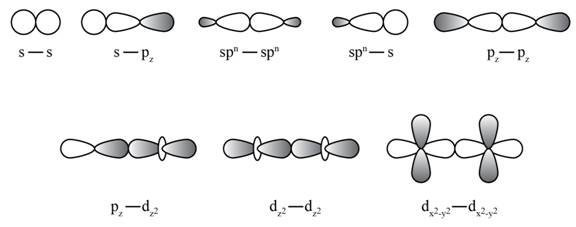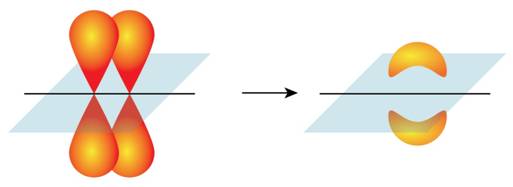
Why do we hybtidize atomic orbitals to explain the bonding in covalent compounds? What type of bonds form from hybrid orbitals: sigma or pi? Explain.
Interpretation: A reason corresponding to the hybridizing of atomic orbitals to explain the bonding in covalent compounds is to be stated. The type of bonds that are formed from hybrid orbitals is to be stated.
Concept introduction: Hybrid orbitals are formed by mixing of atomic orbitals when superimposed on each other in various proportions Hybrid orbitals having same energies are suitable for pairing of electrons which leads to the formation of chemical bond. Both sigma and pi bonds are formed from hybrid atomic orbital.
To determine: A reason corresponding to the hybridizing of atomic orbitals to explain the bonding in covalent compounds and the type of bonds that are formed from hybrid orbitals.
Answer to Problem 1RQ
Due to difference between the predicted structure and the experimental structure, it is rationalized that a new set of atomic orbitals is required which result from hybridization. If there is a “head to head” overlap of orbitals then sigma bond is formed and if there is a “side to side” overlap then pi bonds are formed.
Explanation of Solution
Hybrid orbitals are formed by mixing of atomic orbitals when superimposed on each other in various proportions. Hybridized orbitals are used in the formation of covalent compounds.
Due to discrepancy between the predicted structure and the experimental structure, a new set of atomic orbitals are used, commonly known as hybrid orbitals, which are required to explain the bonding structure.
During the formation of hybrid orbitals both type of bonds, sigma and pi, are formed.
Sigma bonds and pi bonds are formed by overlap of atomic orbitals.
Sigma bond is formed when there is a “head to head” overlap of orbitals and pi bond is formed when there is a “side to side” overlap.
Formation of sigma bond is shown in Figure 1.

Figure 1
Formation of pi bond is shown in Figure 2.

Figure 2
Hybrid orbitals are formed by mixing of atomic orbitals when superimposed on each other in various proportions.
During the formation of hybrid orbitals both type of bonds, sigma and pi, are formed
Want to see more full solutions like this?
Chapter 9 Solutions
Chemistry (Instructor's)
- Lets look more closely at the process of hybridization. (a) What is the relationship between the number of hybrid orbitals produced and the number of atomic orbitals used to create them? (b) Do hybrid atomic orbitals form between different p orbitals without involving 5 orbitals? (c) What is the relationship between the energy of hybrid atomic orbitals and the atomic orbitals from which they are formed?arrow_forward7.57 What observation about molecules compels us to consider the hybridization of atomic orbitals?arrow_forward7.59 What type of hybrid orbital is generated by combining the valence s orbital and all three valence p orbitals of an atom? How many hybrid orbitals result?arrow_forward
- Methylcyanoacrylate is the active ingredient in super glues. Its Lewis structure is (a) How many sigma bonds are in the molecule? (b) How many pi bonds are in the molecule? (c) What is the hybridization of the carbon atom bonded to nitrogen? (d) What is the hybridization of the carbon atom bonded to oxygen? (e) What is the hybridization of the double-bonded oxygen?arrow_forward• explain how hybridization reconciles observed molecular shapes with the orbital overlap model.arrow_forwardWhat hybrid orbitals would be expected for the central atom in each of the following molecules or ions?arrow_forward
- 7.96 Consider the hydrocarbons whose structures are shown below. Which of these molecules would be planar, meaning that all of the atoms must lie in the same plane? Explain your answer in terms of orbital hybridizations.arrow_forwardIn the hybrid orbital model, compare and contrast bonds with bonds. What orbitals form the bonds and what orbitals form the bonds? Assume the z-axis is the internuclear axis.arrow_forwardGive the expected hybridization of the central atom for the molecules in Exercises 21 and 22.arrow_forward
- In each of the following molecules, a central atom is surrounded by a total of three atoms or unshared electron pairs: SnCl2, BCl3, SO2. In which of these molecules would you expect the bond angle to be less than 120? Explain your reasoning.arrow_forwardIt is possible to write a simple Lewis structure for the SO42- ion, involving only single bonds, which follows the octet rule. However, Linus Pauling and others have suggested an alternative structure, involving double bonds, in which the sulfur atom is surrounded by six electron pairs. (a) Draw the two Lewis structures. (b) What geometries are predicted for the two structures? (c) What is the hybridization of sulfur in each case? (d) What are the formal charges of the atoms in the two structures?arrow_forwardThe antibiotic thiarubin-A was discovered by studying the feeding habits of wild chimpanzees in Tanzania. The structure for thiarubin-A is a. Complete the Lewis structure, showing all lone pairs of electrons. b. Indicate the hybrid orbitals used by the carbon and sulfur atoms in thiarubin-A. c. How many and bonds are present in this molecule?arrow_forward
 Chemistry: An Atoms First ApproachChemistryISBN:9781305079243Author:Steven S. Zumdahl, Susan A. ZumdahlPublisher:Cengage Learning
Chemistry: An Atoms First ApproachChemistryISBN:9781305079243Author:Steven S. Zumdahl, Susan A. ZumdahlPublisher:Cengage Learning ChemistryChemistryISBN:9781305957404Author:Steven S. Zumdahl, Susan A. Zumdahl, Donald J. DeCostePublisher:Cengage Learning
ChemistryChemistryISBN:9781305957404Author:Steven S. Zumdahl, Susan A. Zumdahl, Donald J. DeCostePublisher:Cengage Learning
- Chemistry: Matter and ChangeChemistryISBN:9780078746376Author:Dinah Zike, Laurel Dingrando, Nicholas Hainen, Cheryl WistromPublisher:Glencoe/McGraw-Hill School Pub Co
 Chemistry for Engineering StudentsChemistryISBN:9781337398909Author:Lawrence S. Brown, Tom HolmePublisher:Cengage Learning
Chemistry for Engineering StudentsChemistryISBN:9781337398909Author:Lawrence S. Brown, Tom HolmePublisher:Cengage Learning Chemistry: Principles and PracticeChemistryISBN:9780534420123Author:Daniel L. Reger, Scott R. Goode, David W. Ball, Edward MercerPublisher:Cengage Learning
Chemistry: Principles and PracticeChemistryISBN:9780534420123Author:Daniel L. Reger, Scott R. Goode, David W. Ball, Edward MercerPublisher:Cengage Learning





